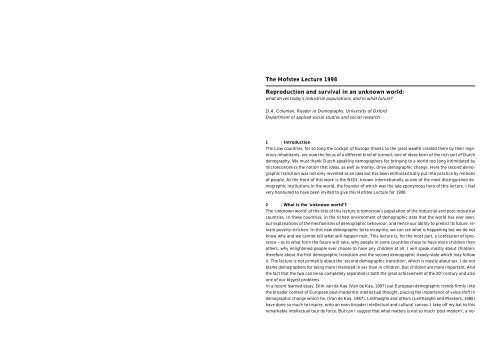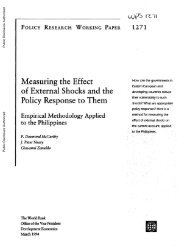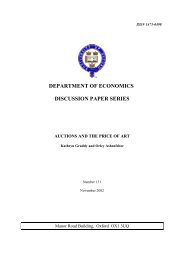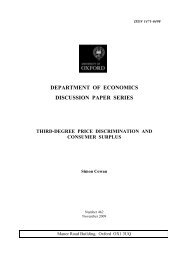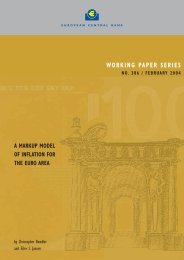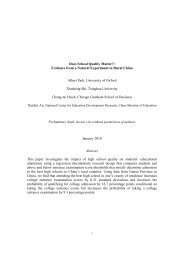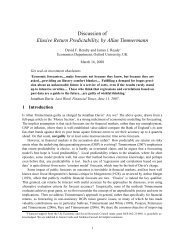Item.pdf - University of Oxford
Item.pdf - University of Oxford
Item.pdf - University of Oxford
You also want an ePaper? Increase the reach of your titles
YUMPU automatically turns print PDFs into web optimized ePapers that Google loves.
The H<strong>of</strong>stee Lecture 1998<br />
Reproduction and survival in an unknown world:<br />
what drives today’s industrial populations, and to what future?<br />
D.A. Coleman, Reader in Demography, <strong>University</strong> <strong>of</strong> <strong>Oxford</strong><br />
Department <strong>of</strong> applied social studies and social research<br />
1 | Introduction<br />
The Low countries, for so long the cockpit <strong>of</strong> Europe thanks to the great wealth created there by their ingenious<br />
inhabitants, are now the focus <strong>of</strong> a different kind <strong>of</strong> turmoil; one <strong>of</strong> ideas born <strong>of</strong> the rich soil <strong>of</strong> Dutch<br />
demography. We must thank Dutch-speaking demographers for bringing to a world too long intimidated by<br />
microeconomics the notion that ideas, as well as money, drive demographic change. Here the second demographic<br />
transition was not only invented as an idea but has been enthusiastically put into practice by millions<br />
<strong>of</strong> people. At the front <strong>of</strong> this work is the NIDI, known internationally as one <strong>of</strong> the most distinguished demographic<br />
institutions in the world, the founder <strong>of</strong> which was the late eponymous hero <strong>of</strong> this lecture. I feel<br />
very honoured to have been invited to give this H<strong>of</strong>stee Lecture for 1998.<br />
2 | What is the ‘unknown world’?<br />
The ‘unknown world’ <strong>of</strong> the title <strong>of</strong> this lecture is tomorrow’s population <strong>of</strong> the industrial and post-industrial<br />
countries. In these countries, in the richest environment <strong>of</strong> demographic data that the world has ever seen,<br />
our explanations <strong>of</strong> the mechanisms <strong>of</strong> demographic behaviour, and hence our ability to predict its future, remain<br />
poverty-stricken. In this new demographic terra incognita, we can see what is happening but we do not<br />
know why and we cannot tell what will happen next. This lecture is, for the most part, a confession <strong>of</strong> ignorance<br />
– as to what form the future will take, why people in some countries chose to have more children than<br />
others, why enlightened people ever choose to have any children at all. I will speak mostly about children;<br />
therefore about the first demographic transition and the second demographic steady-state which may follow<br />
it. The lecture is not primarily about the ‘second demographic transition’, which is mostly about sex. I do not<br />
blame demographers for being more interested in sex than in children. But children are more important. And<br />
the fact that the two can be so completely separated is both the great achievement <strong>of</strong> the 20th century and also<br />
one <strong>of</strong> our biggest problems.<br />
In a recent learned essay, Dirk van de Kaa (Van de Kaa, 1997) put European demographic trends firmly into<br />
the broader context <strong>of</strong> European post-modernist intellectual thought, placing the importance <strong>of</strong> value shift in<br />
demographic change which he, (Van de Kaa, 1987), Lesthaeghe and others (Lesthaeghe and Meekers, 1986)<br />
have done so much to inspire, onto an even broader intellectual and cultural canvas. I take <strong>of</strong>f my hat to this<br />
remarkable intellectual tour de force. But can I suggest that what matters is not so much ‘post-modern’, a no-


